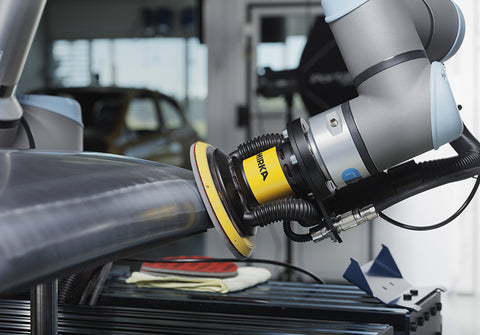Robotic sanding has been around for many years, used by companies in the manufacturing, woodworking, automotive, and aerospace industries. More recently, advancements in robotics and automation have made robotic sanding more accessible to smaller businesses and industries.
Did you know that Mirka offers a range of Robotic Sanders and Polishers? These Robotic Sanders and Polishers have been specially designed for different industries, providing a streamlined, productive, adaptable and safe process for many companies.
Robotic sanders and polishers could change the way you operate your business, making it more efficient and productive, increasing your bottom line and eliminating human error.

What are the benefits of robotic sanding?
Consistent and precise results
Robots are programmed to follow specific, precise sanding movements, creating a uniform result without human errors or variations. Sensors and feedback systems on robots enable them to adapt to diverse surfaces and maintain consistent pressure when sanding. This aids in achieving a consistent surface quality, independent of differences in the shape or material qualities of the workpiece.

High productivity
Robotic sanding systems can work continuously without getting fatigued or requiring breaks. They can operate at high speeds, getting the job done faster than manual sanding. With no variations in the quality of the work, there will be no time spent on reworking or fixing of errors.
Save time and money
By automating the sanding process, companies can save time and reduce labour costs. Robots can work faster than humans, completing tasks in a fraction of the time. The use of robots also reduces the need for manual labour, freeing up human resources for other important tasks.
Less safety risks for staff members
Sanding can be a repetitive and physically demanding task that can cause health risks to workers, like exposure to harmful dust particles or muscle pain. Robotic sanding minimizes the need for manual labour, reducing the risk of injuries and occupational hazards.

Highly adaptable
Robotic sanding systems can be programmed to handle a wide range of shapes, sizes, and materials. They can adapt to complex contours and intricate designs, making them suitable for sanding tasks in various industries, such as automotive, woodworking, aerospace, and manufacturing.
Data analysis for future improvements
Robotic sanding systems often incorporate sensors and monitoring devices that collect data during the sanding process which can be analysed to optimise sanding parameters, improve efficiency, and detect any potential issues or defects in the workpiece.
Mirka’s Robotic Sanders and Polishers are easy to integrate and can be fitted to most robotic arms in the market. They are built for continuous robotic use, freeing up time for tasks that require human attention.
The Robotic Sanding and Polishing machines come in different sizes, and are either vacuum, or non-vacuum, which you can choose based on your requirements. The AIROS Robotic Sanders come in 32mm, 77mm, 125mm, and 150mm. All the Robotic Sanders are circular, apart form the Mirka AIOS 353 CV, which is a rectangular-shaped Robotic Sander. The AIROP 312NV is a 77mm Robotic Polisher.






